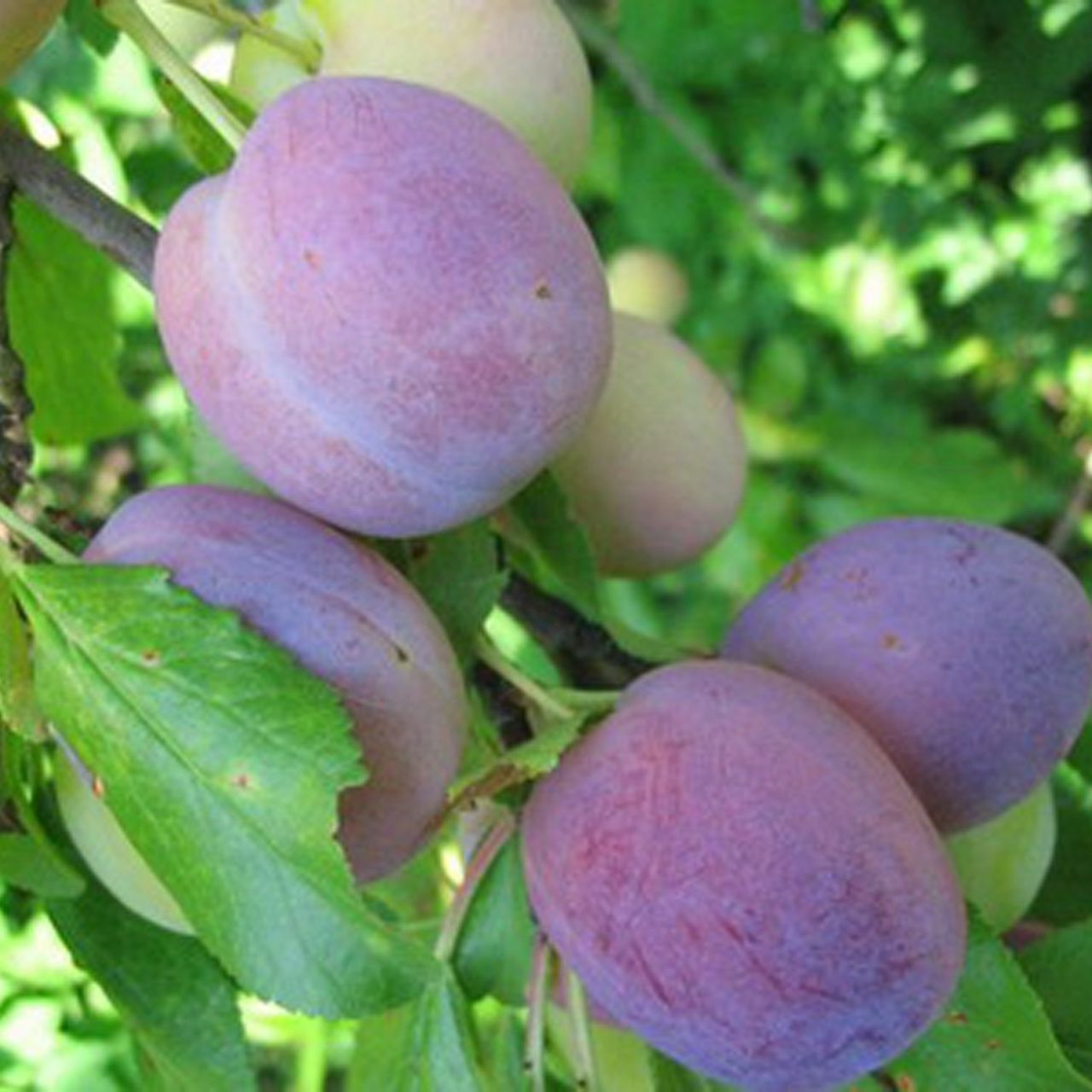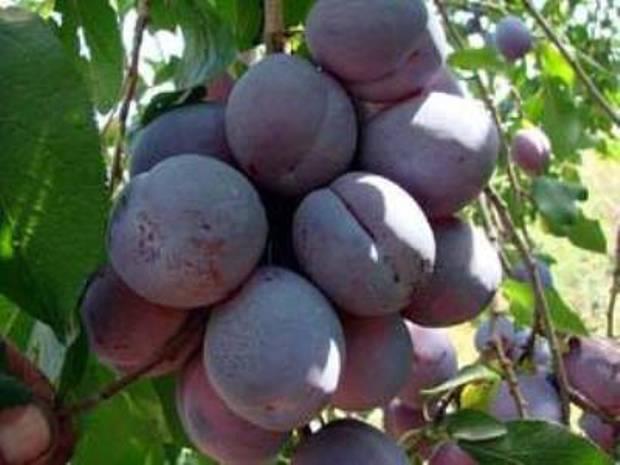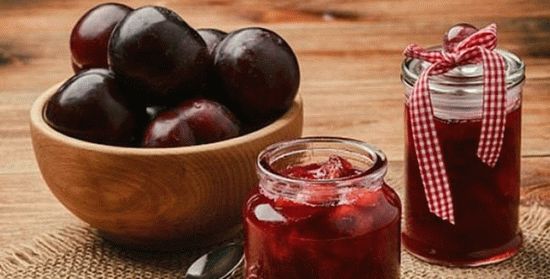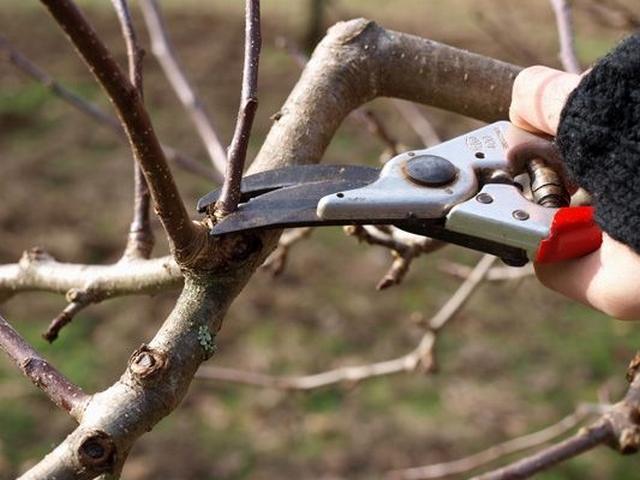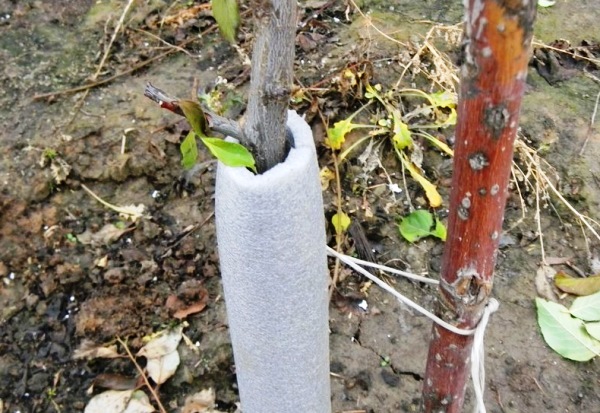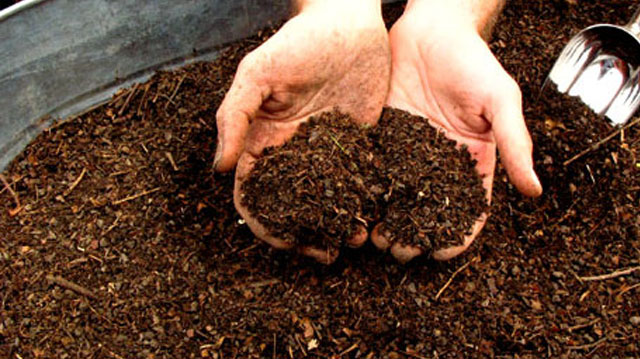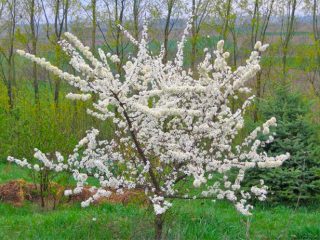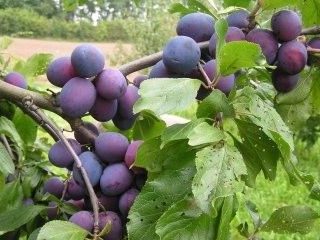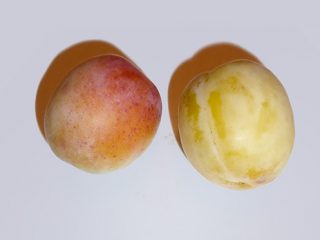Content
- 1 Breeding history of the variety
- 2 Description plum Volga beauty
- 3 Variety characteristics
- 3.1 Drought resistance, frost resistance
- 3.2 Plum pollinators Volga beauty
- 3.3 Productivity and fruiting
- 3.4 Scope of berries
- 3.5 Disease and pest resistance
- 3.6 Advantages and disadvantages of the variety
- 3.7 Landing features
- 3.8 Recommended timing
- 3.9 Choosing the right place
- 3.10 What crops can or cannot be planted nearby
- 3.11 Selection and preparation of planting material
- 3.12 Landing algorithm
- 4 Plum follow-up care
- 5 Conclusion
- 6 Testimonials
Plum Volzhskaya krasavitsa is a common early ripening variety, fragrant and juicy, in great demand among experienced gardeners. Almost no garden in Central Russia is complete without this strong and prolific tree.
Breeding history of the variety
Thanks to the honored breeder of the Samara region, E.P. Finaev, the Volzhskaya beauty plum appeared at the Kuibyshev agricultural experimental station in the early 30s and was included in the State Register of the Russian Federation in 1965. His passion for his craft has helped revive about 20 varieties of plum. Finaev tried many combinations, and the decisive step was the crossing of the Krasnaya Skorospelka and Renclaude Bove varieties.
Description plum Volga beauty
The spherical fruits of the Volzhskaya plum are large, slightly elongated at the edges, purple in color with a red tint. In the middle there is a groove that visually divides the fetus in half.
The peel of the plum fruit The beauty is dense, with a bluish bloom, easily separates from the pulp. The peduncles are firm, thick. The stone is almond-shaped, woody, medium in size.
The height of the Volga beauty plum tree reaches 6-7 meters. The trunk is straight and even, ash gray. The bark is dry and smooth. The rounded crown is located at the top of the trunk with thick and straight shoots. Leaves are light green, with average pubescence, which is typical for plums. The Volzhskaya variety blooms profusely, the inflorescences consist of 2-3 flowers.
The Srednevolzhsky, Lower Volga and Central regions of Russia are considered favorable for planting Krasavitsa plums. The climate and soil composition of these areas contribute to the high yield of the variety.
Variety characteristics
The characteristics of the Volzhskaya krasavitsa plum variety have many advantages. It has attractive qualities: drought resistance, frost resistance, immunity to diseases and pests.
Drought resistance, frost resistance
Plum Volzhskaya is a lover of sunlight, which confirms its drought resistance.
At the same time, it is able to withstand low temperatures due to its thick bark: its frost resistance is assessed as average. When the temperature drops, flower buds are prone to freezing, which provokes their shedding.
Plum pollinators Volga beauty
Plum Beauty can self-pollinate. But this does not exclude the possibility of pollination by other varieties, which increases fertility. This process is facilitated by the planting of the Volga beauty next to the pollinating varieties.
Pollinator varieties | Peaceful, Zhiguli, Ternosliv Kuibyshevskaya, Skorospelka red |
Flowering period | The flowering of the Volga beauty occurs in the second decade of May. |
Ripening terms | Plum variety Beauty is considered early ripening: the period of fruit ripening is from August 10 to September 5. |
Productivity and fruiting
Plum Volzhskaya has a good yield, as evidenced by the yield of up to 25 kg. With age, the Volga beauty can give even more fruits.From trees 5–8 years old, eight to ten kilograms of fruit are harvested, and after 9 years, the variety yields from twelve to twenty-five kilograms. Good fruit density is typical in season.
Scope of berries
Home plum Volzhskaya krasavitsa is a juicy dessert variety. Depending on ripeness, the taste of the fruit varies from sweet and sour to sugary-sweet. Delicious compotes, jelly, jams, preserves, sauces are prepared from the Volga plum. Perfect for filling pies, charlotte turns out to be very tasty. The wine-making qualities of the plum can also be noted.
Disease and pest resistance
Plum variety Beauty, in addition to drought resistance and frost resistance, has a number of important qualities - first of all, it is resistance to many diseases and insect pests.
Advantages and disadvantages of the variety
Reviews of experts about the Volga beauty plum confirm a lot of advantages and notice minor shortcomings.
Dignity | disadvantages |
Drought resistance, frost resistance. | Flower buds are susceptible to frost. |
Plum Volzhskaya beauty self-fertile. Planting with other varieties of plums is possible, which increases the quality of the yield. | Quite tall and wide trees occupy a large area in the garden. |
The volume of the harvest increases every year. | Cracking of the skin of the fetus with high humidity. |
Immunity to many ailments and pests. | Short shelf life of drains. |
Excellent commercial characteristics: large size, beautiful color, tasty pulp. |
|
Landing features
No matter how numerous the advantages of the Volzhskaya plum are, they manifest themselves only after proper planting and with proper care of the fruit tree.
Recommended timing
Gardeners carefully prepare for planting and caring for the Volga beauty plum. The characteristic seasons for the favorable cultivation of plums Volzhskaya beauty from a seedling are autumn and spring. In the fall, the ground is still warm and is ready to receive a new tree. Spring is definitely the most successful period, especially in May: the soil is heated and there is a warm period ahead for the adaptation of the seedling.
- Autumn planting - the last two weeks of September.
- Spring planting - from mid-April to mid-May.
Choosing the right place
Choosing the right place for a seedling is the key to a successful harvest. It is useful to plant Volzhskaya plum on flat areas or on low slopes. The variety loves warmth - it is advisable to place it in those places where the sun shines abundantly, but the possibility of strong winds is excluded.
What crops can or cannot be planted nearby
- As a result of the studies, it was revealed that the Krasavitsa plum does not take root well next to such neighbors as pear, apple, black currant and raspberry.
- It is best to plant a maple tree and black elderberry next to it, which will help it cope with aphids.
- Other pollinating plums will become excellent neighbors for the Volga beauty.
Selection and preparation of planting material
Specialty shops, nurseries, markets offer a wide range of seedlings, but it is better to purchase Volzhskaya plum in proven retail outlets, where the risk of mixing plant varieties is minimal.
- The best choice of planting material is 2-year-old seedlings with a root length of 10 cm or more.
- You should pay close attention to the roots: they should be slightly moistened, there should be no dried branches, and the bark should not be damaged.
Landing algorithm
According to experts, there is a certain planting algorithm for the Volga beauty plum.
- Choose a fertile place in the garden, front garden, vegetable garden, be sure to clear weeds, garbage and dig up.
- Two weeks before disembarkation, dig a hole 50 cm deep and 60 cm in diameter.
- Mix organic fertilizers with the excavated soil.
- Use a wooden support to tie up the tree.
- Drive in a support, pour out mixed soil and plant a seedling.
- The root collar should be positioned so that it rises several centimeters above the ground.
- It is imperative to compact the soil around the drain so that no empty space appears.
- Tie up the plum and water.
Plum follow-up care
After the Krasavitsa plum variety is planted, the period of preventive maintenance begins. Its main stages are: pruning, preparation for winter, watering, feeding, protection from rodents.
Pruning
- The first step is the procedure for pruning the plum. In the event that there is no crown, a part of the ground level by 65 cm is removed from the one-year-old seedling.If there is a crown, then the main shoot is pruned: its rise above the rest of the branches is 20 cm.
- In a two-year-old tree, lateral shoots are shortened by 1/3.
- In subsequent years, the plum is regularly trimmed at the end of March and October.
Preparing for the winter period
Plum Volzhskaya beauty, of course, is a winter-hardy variety, but nevertheless, you should take into account the obligatory tips for preserving it in frosts.
- After the last leaf fall, you should clean the surface of the earth around and dig it to a depth of 15–20 cm.
- Non-fertile young trees should be covered with burlap or thick paper. The use of film is excluded. This procedure replaces the process of whitewashing more mature trees.
- On mature trees, it is recommended to remove dead, dry and covered with various growths zones. Then it is necessary to thoroughly whitewash the trunk and branches of the plum twice. This will protect against pests.
- In case of accidental damage to healthy tissue, gently process with pitch.
Watering
An important aspect in the care is irrigation works, they contribute to the growth and normal development of the Volga beauty plum.
- During the growing season, it is watered up to 5 times with loosening the soil to a depth of 10 cm, and in the autumn period it is dug 20 cm deep.
- During flowering, fruit formation and after harvesting, the volume of irrigation water is 60–80 liters.
- In the last decade of September and the first of October, the volume of irrigation water increases to 150–250 liters.
Top dressing
Plum Volga beauty has large fruits. In order for them to reach their natural size and be saturated with taste and aroma, in combination with the sun's rays and soil moisture, nutritious feeding is necessary.
- The main organic fertilizers include compost and rotted manure, a few buckets of one or the other will be enough.
- Volzhskaya plum is not a fan of acidified soil, therefore one of the following preparations is used: chalk, fluff lime, dolomite flour, wood ash. Dolomite flour has the most effective mineral composition. It is fortified with potassium and magnesium. The norm for use is one or two glasses of any kind of organic matter, depending on the size of the tree. Apply once every three years.
- Lime and mineral dressings should be carried out at different times.
Rodent protection
In winter, rodents tend to eat the trunks and roots of trees. For protection purposes, the Beauty plum should be wrapped with paper, straw, roofing felt, spruce branches, peppermint branches, as well as rags of cloth soaked in creolin.
Diseases and pests, methods of control and prevention
Plum Volga beauty is a versatile plant that is resistant to pests and diseases. Regular preventive measures will save gardeners from serious problems.
The main diseases of the Volga plum: marsupial disease, monoliosis, perforated spot.
Harmful insects attacking the Krasavitsa variety: cherry elephant, plum aphid.
- Marsupial disease - a fungus that affects the fruit of the plum. It is recommended to spray trees with Bordeaux liquid in spring and autumn.
- Hole disease - a disease characterized by branches affected by formations in the form of ulcers on the dry bark. It is recommended to treat with Bordeaux liquid.
- Monoliosis - damage to buds and flowers. It is recommended to spray the plant with Bordeaux liquid for the first time before the leaves appear. Continue the procedure at intervals of 2 weeks until recovery.
- Cherry elephant damages buds, ovaries, fruits, which contributes to a decrease in yield. It is recommended to dig up the ground before flowering, after flowering - to apply a 10% solution of "Karbofos". The drug "Akarin" will help during the growing season, the solution is prepared from 3 ml per 1 liter of water.
- Plum aphid leads to leaf damage. They curl, wrinkle and dry out. Shoots are deformed and do not develop normally. It is recommended in the spring, before flowering, to use a solution of "Bitoxibacillin": 40 g per 10 liters of water. After flowering, apply a solution of "Skor fungicide" (2 ml per 10 l of water) and "Planriz" (5 l per 1 ha). During the growing season, you can use "Zircon" (dilute 1 ampoule in 1 liter of water) or a solution of "Aktofit": 6 ml per 1 liter of water.
Conclusion
Plum Volzhskaya krasavka is an excellent choice for growing. It gets along well with other varieties of plums. Juicy purple fruits will not only decorate the garden, but also delight during the harvest season. Delicious jams and pie fillings will delight you even in winter.
